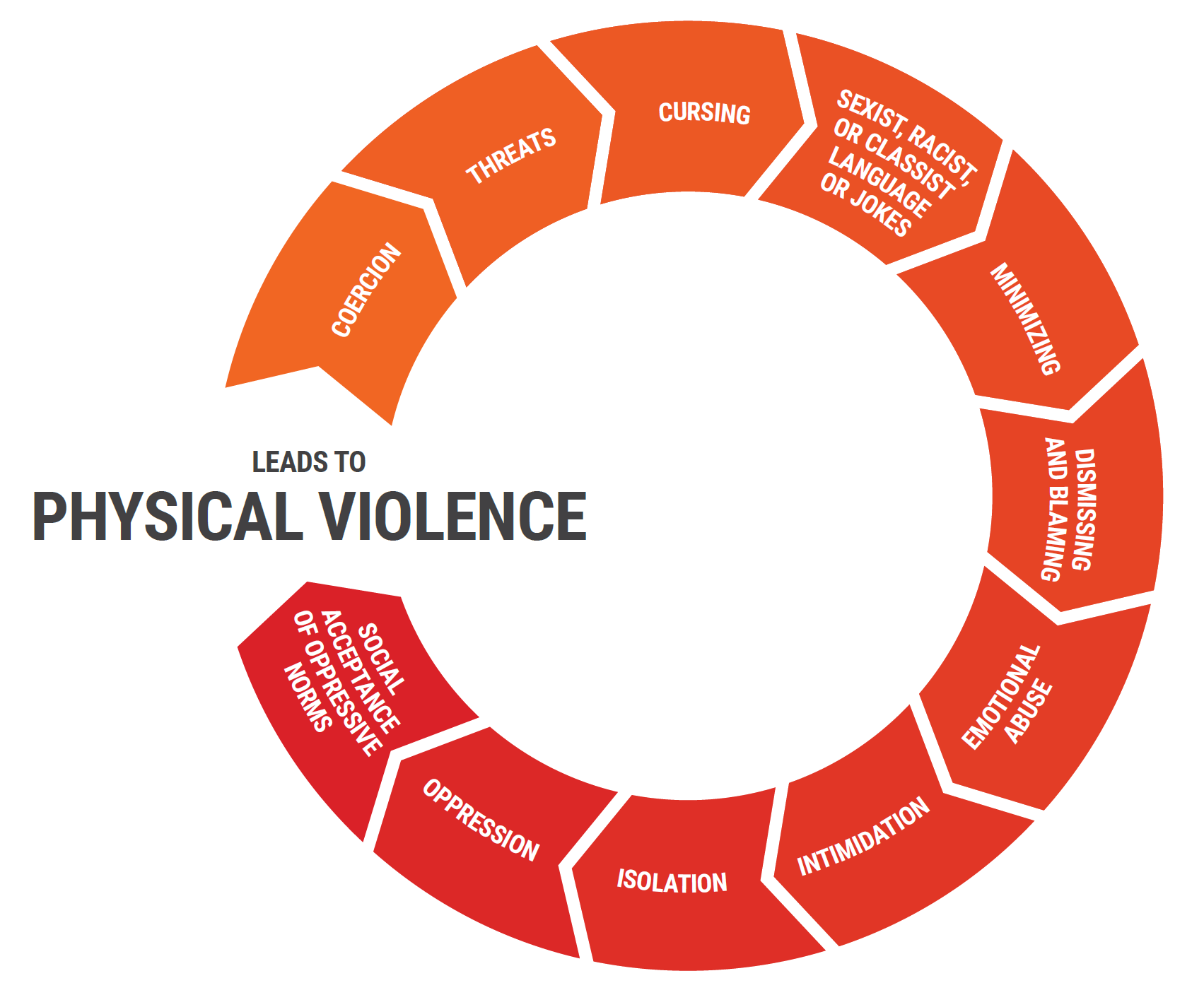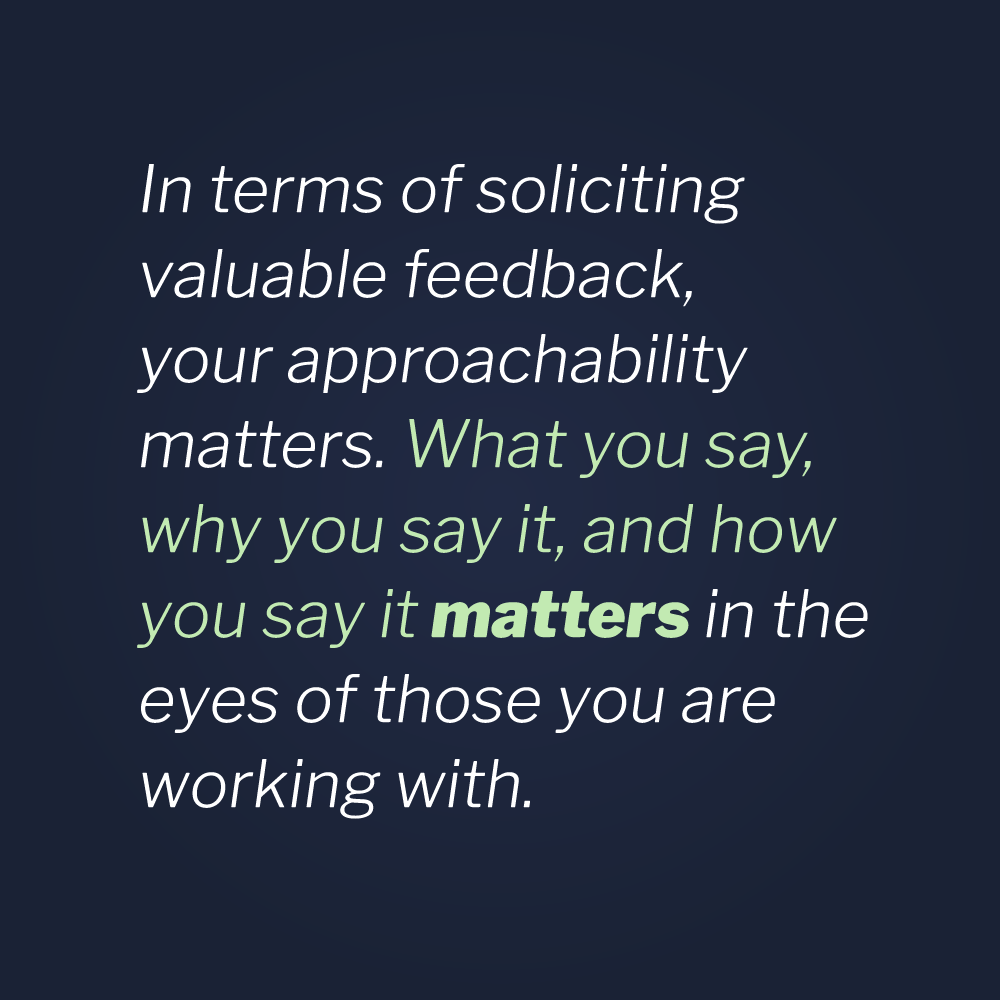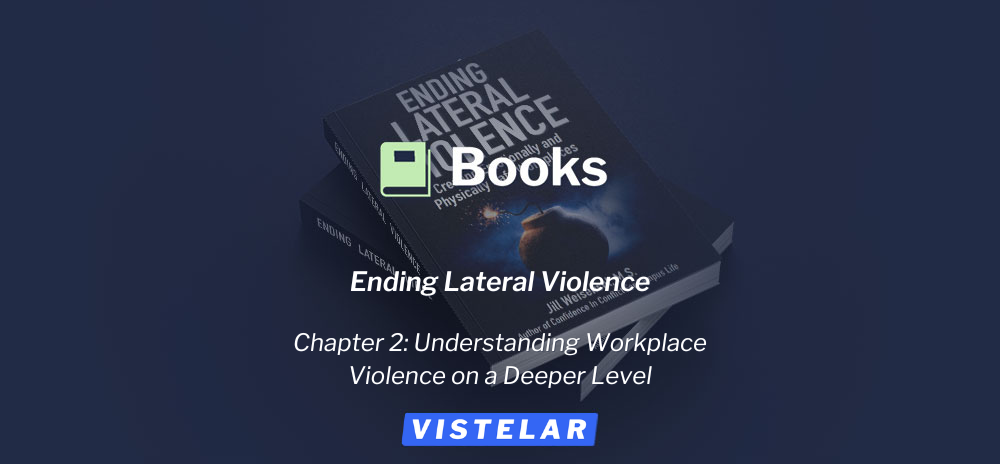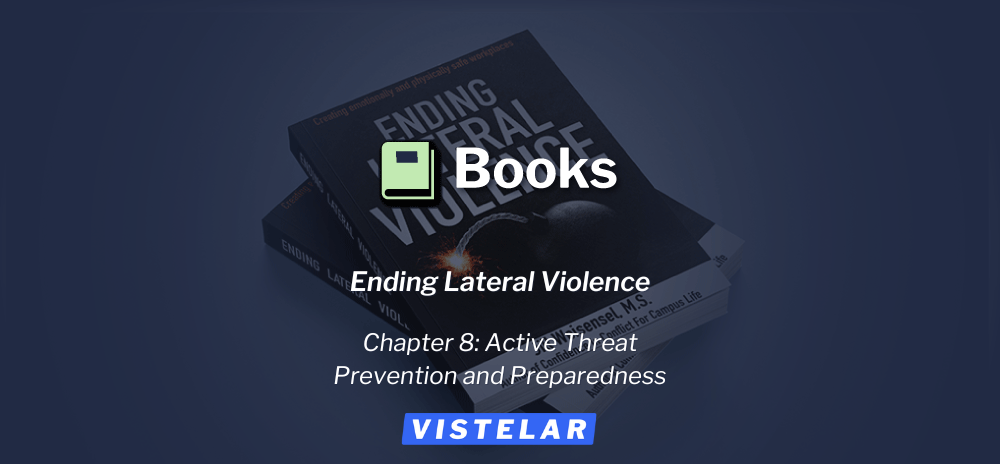Enjoy this excerpt from one of our published books.
Chapter 2
Understanding Workplace violence on a deeper level
No one wants to recognize (or admit) that they are a victim (of anything), so we often fail to identify certain behaviors as victimizing. But no matter how we personally understand and define lateral violence, bullying, abuse, discrimination, or harassment, it is time to expand our understanding of unacceptable behaviors. Regardless if the person engaging in unacceptable behavior is a co-worker, manager, outside client, or member of the public, it is also time to recognize the behaviors that we have become desensitized to as a result of constant exposure to them.
Let’s take a look at this short example:
Once while I was waiting to meet with a physician and his staff about a patient who had threatened his life, I struck up a conversation with one of his nurses. I asked her if anything like this had ever happened before. She said it hadn’t and that she was in shock over the whole incident. Nonetheless, she thought the whole thing was silly and that the doctor was making way too many things.
I then asked her how long she’d been in nursing. She explained she’d been a nurse for more than 30 years and worked in many specialties as an RN and Master Degree prepared nurse. I then asked her if she’d experienced much violence on the job. She replied, ‘Not really. Things really aren’t that bad. A little conflict here and there is just part of the job.’ I then asked her if a patient or visitor had ever shoved her, and she said, ‘Sure.’ I then asked her if anyone had ever slapped her, and she said, ‘I’ve been slapped a couple of times, sure.’ I asked her if she’d ever been kicked, punched, grabbed, or spit on, and she answered yes to all. Finally, I asked her what sort of behavior she considered violent. She replied, ‘Yeah, I see where you’re going, but I used to be an E.R. nurse. A lot of that stuff happened there. After that, I would only get attacked by someone once in a blue moon.’
- Joel Lashley, Confidence in Conflict for Health Care Professionals: Creating an environment of care that is incompatible with violence, Dispelling the Myth: Things Really Aren’t that Bad, 2015, P46
If you work as a nurse in a hospital, you are at least five times more likely to be physically assaulted than the average wage-earner, and if you work in an emergency department, that number at least doubles. It’s time to ask ourselves if this is really the way it has to be. Are we getting anywhere by denying there’s a problem or becoming desensitized to what is going on around us? Are we getting any safer? Have our false notions of acceptable behavior in our workplace environments perpetuated a myth and a standard that keeps us locked in a cycle of violence?
So, what is the solution? Perhaps one can be found by raising our expectations of acceptable behavior, instilling a sense of social responsibility and a shared professional standard of organizational civility. In order to do this, we must expand our understanding of violence and the various behaviors and dynamics that accompany it, in addition to providing the training needed to manage it.
Expanding Our Understanding of Violence: Identifying and Understanding the Cycle of Violence
By expanding our definition of violence and refusing to accept violence as the norm, we will be better equipped to:
- Identify lateral violence.
- Recognize the dynamics that may either intentionally or inadvertently contribute to an environment that condones violence.
- Assess the observable behaviors that signal the potential for violent assaults.
When people curse and otherwise behave inappropriately, they are sending out, in a sense, verbal “radar waves” to see what signals bounce back. When the answer they receive is silence, they begin to gain power and authority over the group.
Once they become comfortable making others uncomfortable, they begin to turn up the heat. Often this takes the form of yelling or shouting. When we remain silent, they also become comfortable shouting at us. Then they begin to threaten us, often in the form of an implied or veiled threat. Examples are, “Make me look bad in a meeting again and see what happens” or “If she calls in sick on a weekend again she’ll be sorry.”
Once people become comfortable implying they will hurt us, they often escalate by blatantly threatening us by saying direct things like, “If you take credit for my work again I will slash your car tires!”
In healthcare, perhaps more than in any other profession, co-workers, patients, and family members routinely threaten staff with absolute impunity and it has become the norm. So, when people get comfortable threatening us and can do so with impunity, why not hit us? That is the question we often place in the minds of our attackers when we fail to train to manage aggression and set limits on bad behavior.
All cycles of interpersonal violence develop this way, whether between nations or individuals, whether it’s a schoolyard fight or a long-term domestic violence relationship. In our personal lives and in the workplace, gateway behaviors, the dynamics of power and control, and language are all components in the cycle of violence.
Identifying Toxic Tactics and Gateway Behaviors
Gateway behaviors are defined as actions that can be a precursor to violence, such as:
- Shouting.
- Cursing.
- Name-calling.
- Insulting.
- Displays of prejudice.
- Dignity violations.
- Intimidating postures.
- Aggressive positioning.
- Indirect threats.
 When gateway behaviors are observed, trained professionals can reliably minimize anxiety, assuage fear, set limits on inappropriate behaviors, and address underlying issues, thereby diffusing the potential for violence. That formula leads to safer environments and better results.
When gateway behaviors are observed, trained professionals can reliably minimize anxiety, assuage fear, set limits on inappropriate behaviors, and address underlying issues, thereby diffusing the potential for violence. That formula leads to safer environments and better results.
If we intervene early in the gateway behavior cycle, we can stop the journey toward violence. If we can stop people from cursing and yelling, they may not graduate to threatening and violent behavior. Ultimately, it is much easier to stop someone from yelling than it is to stop them from hitting. But we can’t even begin if we don’t understand how or when.
The person with the worst behavior sets the tone for what is acceptable for everyone else. Nothing will make exemplary employees leave faster than watching a leader tolerate an inexcusable employee.
When witnessing laterally violent behavior, people often:
- Deny it.
- Distract themselves from it, so it looks like they don’t know it’s going on.
- Remove themselves from the situation.
- Laugh to convince themselves it isn’t serious.
- Overtly ignore it, hoping it goes away.
- Join in, hoping the perpetrator doesn’t target them, too.
Here’s the point: If a manager says nothing when they overhear sexual harassment, they have condoned it and become an enabler of it. Saying nothing tacitly empowers the actor to continue the behavior by sending the message you are unconcerned by it. Inappropriate behavior that goes uncorrected (or inconsistently addressed) becomes the acceptable norm.
“Tolerance for the little things makes the bigger things more likely.”
– Joel Lashley, Author and Conflict Management Expert
Everyone knows not to drop f-bombs in church or talk loudly in a library. But why do so many people yell, curse, and threaten in a hospital? Is it simply because some people behave badly when they’re sick? Or is it because they believe they are entitled to behave badly because they’re sick? Perhaps it’s because healthcare workers believe employees and patients have a right to behave badly. In reality, it’s all of the above.
Once we decide to set limits on bad behaviors, we’ll all be safer. But if we set the bar too low, we often end up acting too late. For example, in healthcare, we have to remind ourselves that nice people don’t hurt us—angry, anti-social, and threatening people do! Because behaviors are connected, people usually build up to violence. They start with refusing to follow visiting hours, refusing to wear visitors’ passes, cursing, yelling, or threatening well before they attack. If we start to set limits when people first begin to violate our social contract, they are more likely to become cooperative and less likely to become violent.
Abusive Workplace Behavior and the Dynamics of Power and Control
Workplace bullying, which is a form of lateral violence, is defined as “systematic aggressive communication, manipulation of work, and acts aimed at humiliating or degrading one or more individuals that create an unhealthy and unprofessional power imbalance between bully and target(s), results in psychological consequences for targets and co- workers, and cost enormous monetary damage to an organization’s bottom line.” (Mattice, C.M., & Garman, K, 2010)
“The difference between how a person treats the powerless versus the power- ful is as good a measure of human character as I know.”
- Dr. Robert Sutton, Stanford Professor and author of Good Boss, Bad Boss
Remember, people talk differently (using a harsher tone or more insulting word choice) and use different tactics when they believe others have an obligation to them and/or are inferior to them. This often manifests itself as disrespectful and indignant behavior.
A comprehensive review of the literature related to abusive workplace practices (refer to the Reference and Resource section of this book) results in the identification of numerous laterally violent behaviors. Most behaviors fall into the categories of discrimination, harassment, bullying, and retaliation. The below list includes those categories and their associated tactics; however, please note that certain behaviors may fall into more than one category, depending on the specific context.
Displaying discrimination:
- Denying access to information, supervision, consultation, or resources such that it has a detriment to the target.
- Excluding (generally targeted exclusion) someone from workplace activities (social or physical isolation).
- Withholding information that is vital for effective work performance.
- Setting unreasonable timelines or constantly changing deadlines.
- Setting tasks that are unreasonably below or beyond the target’s skill level.
- Leveraging harsh criticism or having a different work standard for the target of abuse.
- Manipulating job content by limiting the variety or use of skills; replacing key projects with trivial tasks.
- Using the silent treatment or exclusion.
- Subjecting the target to excessive scrutiny at work (e.g., surveillance, micro-management, monitoring).
Displaying harassment:
- Micromanagement of tasks.
- Making up rules on the fly (without rules or policy to support).
- Encouraging people to turn against someone.
- Changing work arrangements (e.g., rosters or leave) to inconvenience the target.
- Staring with the intent to intimidate.
Bullying:
- Abusive, insulting, or offensive language or comments; disrespect and devaluing.
- Starting or failing to stop destructive rumors or gossip.
- Launching a campaign to oust someone, and the effort is not stopped by the employer.
- Unjustly discounting an employee’s thoughts or feelings; overtly ignoring opinions or views.
- Yelling, screaming, or throwing a tantrum to publicly embarrass an employee.
- Disregarding exemplary work.
- Abusing the performance review process by lying about the target’s performance.
- Stealing credit for someone else’s work.
- Spreading negative rumors or false information about the target.
- Setting an unreasonable workload schedule or pace.
- Creating unrealistic demands (deadlines and duties).
- Failing to provide a physically safe environment.
- Withholding necessary equipment from the target.
- The employer encourages the target to quit rather than face further mistreatment.
Retaliation:
- Assigning an undesirable work assignment or sabotaging tasks related to an assignment.
- Acting in a way that impedes the target’s career development; preventing access to opportunities for growth.
- Declaring the target as insubordinate for failing to follow arbitrary requests or commands.
- Leveraging unjustified criticism or complaints; false accusal.
- Publicly disclosing private or confidential information to humiliate an employee.
Even if your organization has the current luxury of a healthy culture, please do not dismiss or overlook the fact that even the healthiest organizational cultures can still have “pockets of toxicity” within them. This can result from varied working conditions found in different departments but are more often the result of varied (micro cultural) perceptions from different identity groups towards particular leaders. (Sull & Sull, 2022)
Understanding the Role of Language and Mitigated Speech
Mitigated speech was popularized by Malcolm Gladwell in his book, Outliers, where he defines mitigated speech as “any attempt to downplay or sugarcoat the meaning of what is being said,” especially to those in authority (or in perceived positions of authority). In some cases, mitigation can be a good thing. Mitigating your speech may be the most polite and respectful way to get your point across. In others, if you mitigate too much, you may not get your point across to the intended party at all.
It is important to understand the role of mitigated speech in identifying laterally violent behaviors and comments and in how they are reported—or not. Dysfunctional communication structures and the use of mitigated speech directly hinder the ability of employees to report incidents or advocate for themselves in the moment.
For example, someone’s position, title, rank, and relationship will directly impact how a message is conveyed. For example, if the co- pilot of a plane was concerned about the course coordinates set by the primary pilot, the co-pilot may not necessarily be direct in correcting the pilot’s error because their role/position is seen as secondary, or inferior to, the pilot. However, if the co-pilot fails to call out the error or make the correction, it could have devastating results.
The co-pilot must now find a way to balance the need to communicate against the imbalanced power structure of their relationship and roles by communicating the concern as a hint, or suggestion, rather than as a command. These are described as varying degrees of mitigation with which we make suggestions to authority.
Let’s take a look at what mitigated speech sounds like and how it plays out in a real-life example. Using the six degrees of mitigation, let’s try to make the point that you’d like a coworker to stop using sexist language:
- The first option is to use a command:
“Don’t talk about women like that.”
This is the most direct way of communicating a point that you want to make. It’s zero mitigation. It may not come across as sensitive, but it is true. However, using a command is also likely to be the most confrontational in the moment. - The second option is to use a team obligation statement:
“We shouldn’t talk about women like that.”
The use of the word “we” is less direct and is “softer” communication. By using the word “we,” you position yourself as an ally, or an advocate, while also expressing disapproval. - The third option is to give a suggestion:
“I don’t think we should talk about women that way.”
Implicit in this statement is “we’re in this together” and “I think it is a good idea to stop.” It also gives the speaker an opportunity to save face and agree with you. - The fourth option is to offer a query:
“How would you feel if someone talked about your sister like that?” This is a “softer suggestion” because the speaker is conceding that they are not in charge and it offers perspective taking (or, technically, perspective giving) in the moment. It allows the speaker to rethink the repercussions of what was just said. - The fifth option is to state a preference:
“I’d like it if you’d stop making comments like that."
This states a personal preference but is more direct. Explicit in this statement is the expectation of what you’d like the speaker to do in the future. - The sixth option, and the most mitigated way to make a point, is to offer a hint:
“That statement is a little harsh.”
A “hint” is the most mitigated a statement can be and the least likely to get the result you’re looking for because it is the most difficult to decode and the easiest to refuse. However, if you modify the engagement phrase and combine it with a query:
“That statement is a little harsh, don’t you think?”
You may be able to bridge the moment into a productive conversation about why you felt the statement was harsh (because it was demeaning to women).
Furthermore, people who communicate with lots of hints often don’t communicate clearly to people who communicate more directly. And the problem compounds if (a) those who prefer mitigated speech are intimidated by those who use direct speech and/or (b) those who prefer mitigated speech really want those who use direct speech to like them and thus try not to say anything that might cause relational tension. To that end, those who prefer mitigated speech often use a “hedge,” a mitigating word, sound, or construction used to lessen the impact of an utterance due to constraints on the interaction between the speaker and addressee. When used positively, hedges are used to “soften the blow,” avoid the appearance of bragging, and improve politeness (generally understood as “having tact” or being tactful). If used negatively, a hedge could result in the delivery of a passive- aggressive statement whereas you may think you’re being polite, but others think you’re being a jerk. It could be the difference between
“what was said,” and “what was meant by what was said.”
Hedges are typically adjectives, adverbs, or clauses and may be intentionally or unintentionally employed in both written and spoken communication. Consider this example. Would you rather your boss say to you:
“There are things we need to address,”
- or -
“There are just a few small things we need to address.”
By adding the word “few” and the adjective “small,” the speaker relays a more precise message (it is far less vague and open-ended) and also softens the blow to the receiver.
The above sentence could be further improved by changing the word “address.” The word “address” could mean any number of things to different people, and quite frankly, if on Friday my boss said, “There are things we need to address on Monday,” and then told me nothing further, I would be a complete wreck all weekend. My mind would spin out on all of the things I possibly could have done recently that we need to “address.”
We could restructure this sentence in numerous ways and modify the delivery of the words to flush out dozens of possible reactions by the receiver. For the sake of this example, if you know that your employee will overthink and worry about what is coming on Monday, you need to be more direct in your message.
However, direct does not mean harsh. It is possible to be “firm but polite.” You can deliver a strong message with a soft tone. In the above example, we could deliver a more precise message by stating:
“On Monday, I’d like to talk with you about that quarterly report. There are a few parts we can clean up.”
And even if you don’t know how the employee will react, it is more respectful and more likely to elicit your intended result by being impeccable with your words. Always say what you mean and mean what you say—the precision of word choice matters. Words mean different things to different people as a result of varying cultural backgrounds, experiences, biases, and assumptions, and it is important to be mindful of that when interacting with someone.
With the goal of what to say and when to say it in mind, researchers Megan Reitz and John Higgins have identified multiple intertwined issues in their book Speak Up: Say What Needs to be Said and Hear What Needs to be Heard. Reitz and Higgins state that multiple factors come into play when making a decision to speak up or listen up at work. First, people must trust in the value of their (or the other person’s) opinion and weigh that against the risk of speaking up (or being spoken up to). Secondly, all parties involved must navigate an ever-changing political environment, assessing how various social titles and labels (such as gender, age, job title, and race) affect speaking up and listening up while also having the “capacity to judge how to say things” or “invite things to be said in the moment.”
gender, age, job title, and race) affect speaking up and listening up while also having the “capacity to judge how to say things” or “invite things to be said in the moment.”
All of those factors directly impact what is said, how it is said, when it is said, and who says it. This is a far too overlooked and undervalued construct playing out in the workplace, especially as it relates to workplace incivility in understanding who has a voice and the nature and quality of feedback offered to those in leadership roles.
In terms of soliciting valuable feedback, your approachability matters. What you say, why you say it, and how you say it matters in the eyes of those you are working with. If you think you are coming across as genuine and sincere, but your body language and tone send the message that you don’t care, that is the message that will be received by others. People hear what they see and only remember how you made them feel.
Trauma in the Workplace
Trauma is the exposure to an incident or series of events that is emotionally or physically harmful or life-threatening, or that has lasting adverse effects on an individual’s well-being. For the purpose of this book, the causes of trauma include physical, sexual, situational, contextual, cultural, and emotional abuse, such as the emotional abuse someone is subjected to as the target of laterally violent behaviors over time.
“Trauma not transformed will be trauma transferred.”
– Ashley Judd, American actress
Trauma comes in many forms, including vicarious, which results from exposure to hearing (or being witness to) the trauma of others. This is often seen in military personnel, law enforcement/first responders, counselors, and healthcare workers, as they are typically exposed to a higher number of traumatic incidents over the course of their careers than those not working in those professions.
The potential health implications of traumatic events do not have to be lifelong. We can create environments and cultural/social systems that employ trauma-informed principles. This includes creating a supportive atmosphere (rather than a defensive one) and a caring, inclusive environment for everyone. A supportive atmosphere is made possible by creating a functional communication structure supported by policies, consistent training, and follow-through.
First, we must acknowledge that everyone’s life experiences are different and recognize how organizational practices may trigger painful memories and re-traumatize those with trauma histories. Organizations may inadvertently create stressful or toxic environments that interfere with the well-being of staff and the organizational mission.
This acknowledgment can also be framed as being trauma responsive. Being trauma responsive (or having trauma responsiveness), means acknowledging the existence of past trauma (in both ourselves and in others) potentially impacting current behaviors. The key point to remember is that everyone has had past events and experiences that may prevent them from responding or performing now, in the moment, as you may expect them to. Trauma responsiveness is an effective approach to minimize the chance of re-traumatizing someone.
Trauma responsiveness allows us to create an environment that provides:
- Safety: Where all people have the right to be physically and psychologically safe.
- Trustworthiness and transparency: Where operations are conducted with transparency to build and maintain trust.
- Peer support: Where interpersonal relationships contribute to establishing hope, trust, and collaboration.
- Collaboration and mutuality: Where power differences are leveled between organizational staff, demonstrating that healing happens in relationships and the sharing of power and decision making.
- Empowerment: Where employees are provided a voice and a choice, building on individuals’ strengths, experiences, and resiliency.
- Common ground: Where cultural stereotypes and biases are cast aside, and policies and practices that are responsive to racial, ethnic, and cultural needs are incorporated.
“An environment that is not safe to disagree is not an environment focused on growth - it’s an environment focused on control.”
– Wendi Jade, American author
Why Don’t People Report?
The subtlety of behaviors, such as not including someone in an email list or failing to give someone the time needed to prepare for a meeting, is often viewed as trivial. But when you evaluate those behaviors in the broader context of the environment described above, we begin to see just how pervasive and destructive they are.
Despite best efforts to research prevalence, laterally violent behaviors often go unreported for a variety of reasons, including the primary driver of strong emotions such as fear and embarrassment:
- Many studies have shown that the majority of employees are too scared to report for fear of being seen as untrustworthy or a troublemaker.
- People are also afraid of the threat to their personal standing, professional status, being singled out or isolated, and being overworked. Fear is understood as inhibiting all reporting.
- Many employees fear coming forward because they don’t have the confidence in the leader to do what is right.
- Employees fear accusations of incompetence, or they think their employer might assume they were the cause of the violence.
- Employees may be embarrassed and hesitant to report violent behavior.
- Employees may feel embarrassment or fear of shame or the response of management or friends.
Some of the additional reasons why people don’t report include:
- The lack of a consistent definition of violence or the bar being set too high to be considered violence.
- A pervasive acceptance of threatening behavior and violence as part of the job.
- A belief that a threat of violence is not significant enough to report.
- Not knowing what to do. Employees may not know what constitutes inappropriate behavior or may be unaware of internal reporting systems.
- Lack of supervisor support.
- The role of the person using the behaviors: is the person a high performer? A friend of the boss? The boss?
- Someone in a supervisory role is the offender.
You can work to mitigate employees’ fears about reporting by:
- Raising awareness of lateral violence.
- Educating about the importance of reporting and the damaging personal and organization costs associated with not reporting.
- Being open and transparent about not tolerating laterally violent behaviors and the need to create a safe and inclusive environment for everyone.
- Consistently responding to and following up to reported incidents.
Key Takeaways
- Tolerance for the little things makes the big things more likely. We must raise our expectations of professionally acceptable behavior.
- Gateway behaviors, the dynamics of power and control, and language are all components in the cycle of violence.
- If we intervene early in the gateway behavior cycle, we can stop the journey toward violence.
As we get older, bullying doesn’t disappear. The methods and tactics just become more subtle and ambiguous. - Understand the role of mitigated speech and leverage the power of the various degrees of mitigation when addressing issues in the workplace.
- Trauma responsiveness refers to the way caring people are trained to respond to the emotional injuries and scars of trauma and reduces the chance that we will re-traumatize someone.
- Workplace violence incidents often go unreported for reasons such as not knowing what behaviors to report, fear of retaliation, and embarrassment in facing co-workers









